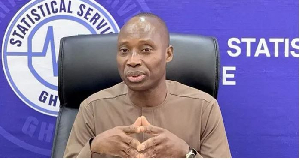The issue is so serious, the nation cannot afford to let it rest. It was touted as the best value for the people. However events surrounding the sale of one of the nation’s vital assets, paints a rather peculiar picture; a muddled image so complex, it may well be rocket science or at least that is what the nation is being led to believe.
The people however, are not averse to grappling with complex issues, even if it is rocket science. We need to resort to an appropriate algorithm to decipher this scenario. At stake is the pensions of millions of hard-working Ghanaians. Monies that they have placed aside, for the time that they can no longer apply themselves to the rigours and tedium of working life.
Trigonometry - it is that branch of mathematics which is taught at secondary schools throughout the nation and studies the relationship between angles and lengths in a triangle. Our interest will be focused on triangulation, which also appears in geometry and deals with the process of identifying or mapping the location of an object by using the distances and angles from multiple reference points.
As a concept, it has wider applications and in areas such as sociology, psychology and forensics, it allows the use of multiple methods to investigate, analyze and validate information. It has practical applications in the plotting of coordinates to determine trajectories for accurate missile deployment. It is therefore an appropriate application to use in a complex scenario which sounds like rocket science.
We need to identify the reasons why the investment arm of SSNIT; Merchant Bank was sold and the probable effects of the sale on the nation and it people. Primary to our objective is the question: “Was the sale of the Merchant Bank, best value for the nation or a great pension swindle?”
We will employ the social science methodology, because the issue is conceptual and we do not actually have to measure angles, distances or plot coordinates. However we still have to examine the issue from multiple angles to validate our conclusions. Our focus will be on the players and activities of the Merchant Bank and SSNIT, Engineers and Planners, Fortiz Equity and the President.
We can skip the controversy on the bidding process on the sale of the Merchant bank, because the salient conclusion, based on the bids received indicated that Rand of South Africa had the most appropriate bid in the process. In addition to offering a higher bid, it was prepared to chase down all the defaulting debtors of the Merchant Bank. We can only surmise why, in the prevailing conditions at the time, those making decisions on behalf of the nation, deemed it inopportune.
The most significant change to emerge, following the controversial takeover of the Merchant Bank by Fortiz Equity, appears to be an overhaul of the bank’s management. So the question is: “If what was needed to turn the Merchant Bank round, was a new management structure or culture, why was that not obvious to the government in the time prior to the sale?”
The government would have had recommendations, evaluations, assessments and audits, which would have clearly pointed out this fact. This would have been available from the various departments of state and the numerous qualified civil servants and professionals working for the government.
Unless of course, in the face of all such facts, recommendations, assessments and audits, the government for some strange reasons, chose to move forward with the sale with clear intent and a full knowledge of an objective it had already made a decision on. It appears that someone had worked out, that any outcry will subside, enabling the main purpose for which such a puzzling transaction was made, to be carried out.
On the issue of intent, the nature and the speed of the takeover by Fortiz Equity and the facilitation and the expedition of the process by the government, offers the most significant clue.
The retention by the government, of the 1% equity stake in Merchant Bank is a strong indication. What this means is that, by being a shareholder, SSNIT still had direct access to the bank and could transfer any level of capital for investment. The significant drawback is that by being a minority shareholder, it has no control over the manner in which any such investments will be made. It is a loophole and it allows the surreptitious transfer the “liquid net worth” [money] held by SSNIT, which is also the pensions of the people of Ghana and turn it over, placing it under the control and influence of the controlling stakeholder Fortiz Equity.
Under no obligation to declare the source of its funds, Fortiz Equity can declare any such transfers as their own and use it to any ends that they want. For example giving $43million to an associate to pay an outstanding debt.
Given the level of expertise which was brought to bear [ both legal and financial ], the entire transaction appears to be nothing but a carefully arranged plot. Such a ploy jeopardises the pension funds of millions. It will prevent scrutiny on the abuse or indiscriminate use of the pension funds.
What is the motive behind the government setting up a vital state asset at a loss and in a manner which allows large sums of money belonging to the Ghanaian people to be funnelled to parties, who cannot be held accountable?
Let us take a look.
The entire Merchant Bank Saga erupted, following the publicized issue of the manner in which the CEO of Engineers and Planners failed to honour payments on a loan made to the tune of some $43million.
Now here is the snag:
Engineers and Planners typified by its CEO reportedly got into difficulty, because it could not come up with enough money to repay the loan. Against strenuous attempts by Merchant Bank to shake it down for the debt, the situation was stymied by the intervention of the government. However following the conclusion of the transfer of Merchant Bank to Fortiz Equity, the president announced that all debtors [overtly referring to Engineers and Planners ] will now honour their debts to the state. Shortly afterwards, Engineers and Planners reportedly stumped up in a lump sum, the money that they have supposedly been struggling to pay.
It just sounded a bit odd.
$43 million is not pocket change. If it were so, the money would not have been borrowed. So where could that amount be sourced from in such a lump sum. The proximate entity connected to Engineers and Planners, and capable of holding such a reserve was the Social Security and National Insurance Trust. This was in the form of its “liquid net assets”, which is also the pension funds of the millions of Ghanaian workers and worth in the millions of dollars. The same fund which is accessible to the Merchant Bank through the 1% equity held by SSNIT. The same bank controlled by Fortiz Equity, the consortium which was in line to receive circa 60 percent of any debts “recovered“ . The same consortium which had an association to the CEO of Engineers and Planners through its lawyers. The same lawyers associated to the presidency.
It just does not make sense when after a series of controversial incidents, an individual who has had difficulty in paying a loan, suddenly turns up and slap the entire amount down. Even large corporations, after such a scenario will usually renegotiate repayments by instalments. You only do otherwise when you have a stash of money or have suddenly come into some fortune.
For example, when the pension funds of an entire nation worth in the hundredths of millions has been surreptitiously passed to you and your associates, you can afford to honour a paltry forty-three million , for which some are giving you some aggravation and it will all appear as if it is all coming from your own pocket.
Lets hold that conclusion for the moment.
If we go by the regular banking practice, defaulting on a loan can be a very costly development. It will mean that given the duration that Engineers and Planners defaulted on the loan, the cumulative repayment index would have gone up significantly. Bolstered by charges and penalties within the period, it would have increased the $43 million repayment. Strangely in the case of Engineers and Planners, its loan index reportedly stayed the same. A banking first.
So to honour the repayment as announced by the president, Engineers and Planners would have had to stump up only $17.2million, erasing any benefit, that the nation wanted by lending the $43 million to Engineers and Planners [adding a hefty loss in the process]. The remaining 60% of the loan? Well, what is $25.8 million among friends. After all you did not actually work for it.
So! while the nation rasped its teeth with chagrin, it was probably champagne cocktails, exquisite hors d’oeuvres and caviar all round for others, as they toast $25million and change of other people’s pensions.
Unbelievable!
We will continue with this discourse and we would be looking to bring all the various elements together . We need a motive, we have intent and we know the opportunity exists.
To identify a motive we need to examine the possible trajectory of the central issue at stake. Why is the government acting in a manner which is likely to jeopardise the pension funds of millions of hard-working Ghanaians? What is likely to happen to the pensions, going forward. We have to get it right, because if we do not, 60% or more of people’s pensions is a staggering amount, which may well end up in some pretty odd places.
Jedd Rii.
Opinions of Monday, 28 July 2014
Columnist: Rii, Jedd














